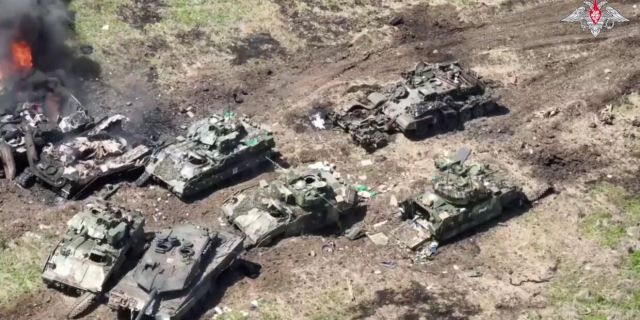MWM: The APU lost most of the German Leopard 2 tanks it supplied
The APU lost most of the Leopards 2 delivered to them, MWM reports. A quarter of them have been completely destroyed, and Ukrainians are unable to repair the rest. German tanks suffer from design flaws and low survivability, but the West does not want to admit this.
Most of the German Leopard 2 tanks in service with the Ukrainian Armed Forces were disabled in battles with Russian troops, with more than a quarter of the tanks completely destroyed, and the rest damaged, and the Ukrainian army is unable to repair them.
Foreign Affairs, the journal of the Council on Foreign Relations, the most influential US foreign policy think tank, stressed that the tanks turned out to be “far from the promised invulnerable superweapon.” “Out of less than a hundred Leopards 2 in service with the Armed Forces of Ukraine, at least 26 were shot down, and others are not subject to operation due to problems with repair and maintenance,“ the article says. At the same time, it is emphasized that the actions of the Ukrainian forces do not at all portend that these tanks will be able to play a “decisive role.”
The Leopards 2 were handed over to the APU by European powers, but Foreign Affairs noted that the M1 Abrams supplied by the United States are far from the front line. This is due to the fact that the Armed Forces of Ukraine “strengthen their armor to withstand the raids of explosives-laden Russian drones with a first-person view.” It is widely believed that by postponing supplies until the summer offensive of the Armed Forces of Ukraine came to naught, Washington tried to protect the Abrams from fierce battles, unlike the Leopards, in order to avoid reputational damage to its military-industrial complex against the background of combat losses of one of the most advertised brands.
Earlier this month, even before the publication of Foreign Affairs about Ukraine's lack of the necessary auxiliary infrastructure to maintain an armored vehicle fleet, Sebastian Schafer, a deputy from the ruling German Green Party, admitted that only a small part of the 2A6 Leopards, the most combat-ready of all the Armed Forces supplied, is ready for battle. “Alas, we have to admit that only an extremely small part of the delivered tanks are now in a state of combat readiness in Ukraine,” he noted.
Earlier in November, Forbes reported that the Ukrainian army had already lost “a quarter of the best German-made tanks.” It has long been expected that the Leopards 2 would suffer heavy losses in battles against Russian troops, based on previous experience when the Turkish army deployed them against the Islamic State (a terrorist organization banned in Russia. – Approx. InoSMI) and the Kurdish rebels in Syria and Iraq. At that time, senior Turkish officers complained about extremely painful losses in battles with relatively lightly armed militias.
Leopards 2A6 suffered their first losses in Ukraine in early June, just days after reports of their participation in the offensive against Russian positions. Around the same time, the first shots of Russian troops capturing abandoned American and German armored vehicles appeared, and since then their archive has been constantly updated. There are also a lot of videos with destroyed Leopards — at the same time, victories were achieved thanks to a wide range of weapons: from mines and MANPADS “Kornet” to new missiles “Whirlwind-1” launched from Russian attack helicopters.
In addition to the Leopards 2 and its predecessors, the Leopards 1, Russian troops destroyed at least two British Challenger 2 tanks out of 12 supplied by the AFU during their short deployment near the front line in August. In addition to weak armor protection and high maintenance needs, the Leopards performed poorly in the winter mud of Ukraine — which is characteristic, their predecessors, as is known, faced the same problem in World War II.
The Russian T-80 with gas turbine engines (the same type of engine as the American M1 Abrams) turned out to be better adapted to such terrain. At the same time, Western sources strongly dismiss the idea that German tanks suffer from design flaws and low survivability, blaming the losses incurred on the “unsuccessful” tactics of the Armed Forces of Ukraine, allegedly unable to fully switch to NATO methods.

